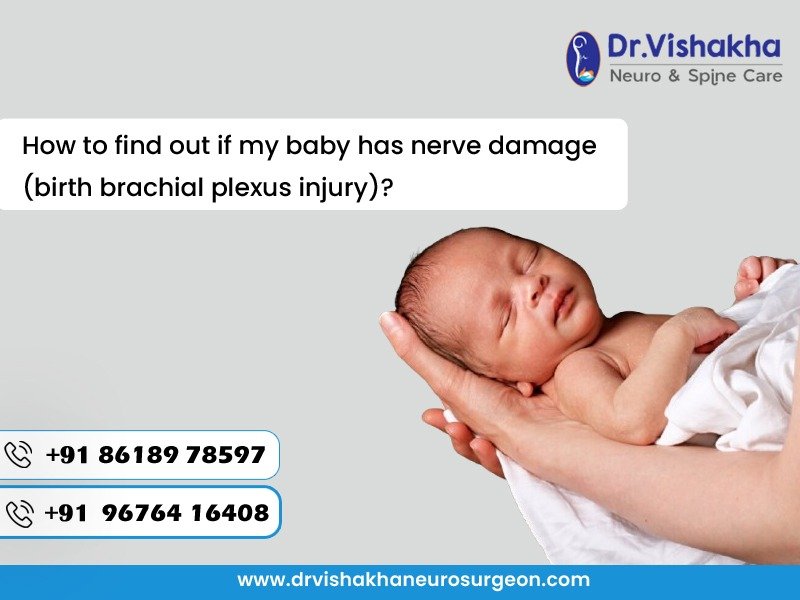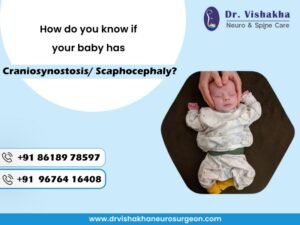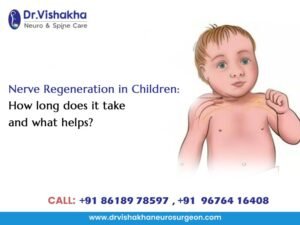Dr. Vishakha Karpe
MBBS, DNB(Surg), MCH (neurosurgery), MRCS (UK),
Fellowship in neuroendoscopic surgery.

Identifying nerve damage in a baby is crucial for their growth and development. It can affect movement, sensation, and reflexes and, if left untreated, can lead to long-term complications. Factors like birth injuries, genetic conditions, infections, or congenital anomalies can cause nerve damage. Physical and behavioural abnormalities can result, necessitating careful observation and medical evaluation.
Early Signs of Nerve Damage in Babies.
- Motor symptoms
Motor symptoms are early signs of nerve damage affecting muscle function. These symptoms include muscle weakness, floppiness, and stiffness in babies. Muscle weakness may result from damage to motor nerves controlling muscle strength. Hypertonia, or rigid muscles, may be linked to conditions affecting upper motor neurons. Delayed motor milestones, asymmetry, and poor reflexes can also indicate nerve damage. Delay in motor milestones, preference for using one side of the body, and absent or diminished primitive reflexes can all indicate nerve damage. These symptoms can indicate the presence of nerve damage in the brain.
- Sensory symptoms
Nerve damage can disrupt sensory perception, causing symptoms such as reduced sensitivity, irritability to stimuli, and vision or hearing issues. These symptoms may be due to peripheral nerve injuries affecting sensory pathways or nerve pain or hypersensitivity. Infants may also struggle with tracking objects. Careful observation of these signs can help healthcare providers identify the underlying causes and appropriate interventions. The persistence of these symptoms can guide healthcare providers in determining the underlying causes and determining the most effective treatment for the affected baby.
- Autonomic symptoms
The autonomic nervous system is responsible for controlling involuntary functions like breathing, digestion, and temperature regulation. Signs of nerve damage in this system include feeding difficulties during breastfeeding or bottle feeding, temperature dysregulation in hands and feet, persistent pallor or cyanosis in certain body parts, and abnormal breathing patterns or slow heart rate. These symptoms require careful observation and medical evaluation to determine their underlying cause. The autonomic nervous system plays a crucial role in maintaining bodily functions, and nerve damage can lead to complications such as impaired coordination of autonomic and cranial nerve functions.
- Visible physical signs
These signs can be observed through physical examination and may vary depending on the condition. Common visible signs include skin changes like pallor, jaundice, cyanosis, swelling, oedema, inflammation, posture and movement.

Causes of nerve damage.
- Birth trauma are the most common causes that can occur due to prolonged labour, the use of delivery instruments like forceps or vacuum extraction, and shoulder dystocia, which can compress or stretch nerves and cause injuries to the brachial plexus.
- Congenital conditions like Spina Bifida, genetic disorders like Charcot-Marie-Tooth disease, can cause nerve damage and brain damage during development.
- Maternal infections like rubella and toxoplasmosis can affect the baby’s nervous system, while postnatal infections like meningitis or encephalitis can cause inflammation and nerve damage.
- Peripheral nerve injuries, such as brachial plexus injuries and facial nerve injuries, are often caused by shoulder stretching or tear during birth. Post-birth trauma, such as accidents or falls, can damage nerves in newborns, while improper handling can lead to nerve injuries.
- Toxins and medications can affect nerve development during pregnancy, while heavy metal exposure, such as lead or mercury, can harm the nervous system.
Diagnosis and prognosis
Diagnosis
Healthcare providers use various tests to confirm nerve damage, including clinical examination, imaging studies like MRI or CT, electromyography, nerve conduction studies.
Prognosis
Infants with nerve damage often experience varying outcomes, with some resolving with early intervention and others requiring long-term care, requiring regular monitoring and tailored care plans.
Early detection of nerve damage in babies requires vigilant observation and medical evaluation. Parents should be aware of symptoms like weakness, developmental delays, and abnormal reflexes. Consulting pediatric neurosurgeons and pursuing diagnostic tests can ensure necessary interventions, improving the baby’s quality of life and providing hope for a healthier future.
About Dr Vishakha :
Dr Vishakha Basavraj Karpe is a highly skilled senior consultant at Rainbow Children’s Hospital in Banjara Hills and Hydernagar Hyderabad. She is known for her comprehensive care approach and is one of the few dedicated leading paediatric neurosurgeons in the city and India with over ten years of extensive experience in pediatric neurosurgery. Her expertise includes treating hydrocephalus, spinal dysraphism, craniosynostosis, paediatric brain infections, brain and spine tumours and stroke surgery.
She has a special interest in craniosynostosis surgery, which is done only in very few centres in India.
Proficiency of Dr Vishakha:
-
-
Hydrocephalus (increased fluid in the brain): The procedure involves an endoscopic third ventriculostomy and CSF diversion (VP shunt) to treat complex hydrocephalus.
- Craniosynostosis (abnormal head shape due to untimely cranial sutures fusion) surgeries: Helmet therapy is a technique that is used in both endoscopic and open surgery.
-
- Spinal dysraphisms(Spina Bifida)- (spinal abnormalities present by birth) – surgical repair
- Encepahaocles repair surgery.
-
- Vascular conditions and stroke surgeries: revascularization surgeries for moya moya disease.
- Pediatric brain and spine tumour surgeries.
-
- Pediatric brain and spine infection surgeries: Endoscopic and open surgeries for brain and spine infections.
- Pediatric traumatic brain and spinal injury.
- Antenatal counselling for congenital fatal neurosurgical conditions.






